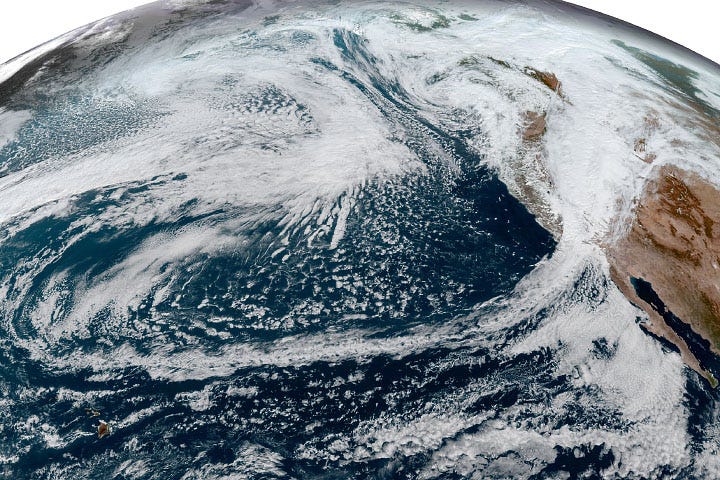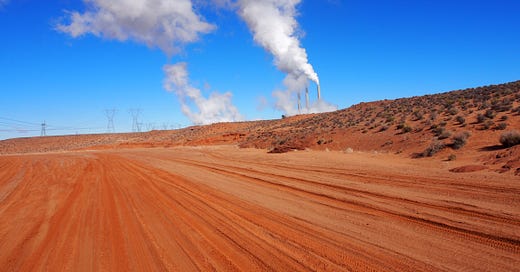Welcome to Planet Week, where we highlight the last week of climate news and what it means for our Planet. If this email was forwarded to you, smash that subscribe button.
Now, onto the latest climate stories:
Last week, Hertz ordered 100,000 Teslas, leaked Facebook docs revealed its climate denial problem, and the two-week global climate summit, COP26, kicked off.
In case you missed it, here’s what else happened around the Planet:

Sunday, October 24
U.S. sandwiched by extreme weather
This past week, the United States had some scary weather from coast to coast, all made worse by climate change.
It started on the West coast with two rapidly intensifying storms, dubbed bomb cyclones. Northern California went from drought to flood overnight, as the storms dumped up to 10 inches of rain, reports the Los Angeles Times.
Later in the week, remnants of those storms cut across the country, bringing tornadoes to the midwest and hurricane-force winds to the Northeast. Up to 600,000 New Englanders lost power leading into the weekend, USA TODAY reports.
CBS News covers both developments.
Monday, October 25
Greenhouse gas levels hit new high
The level of greenhouse gases in the atmosphere reached a new record last year, putting the world "way off track" of its goal to slow climate change, according to the World Meteorological Organization.
Despite the pandemic-driven decline in new emissions, the concentration of carbon dioxide in 2020 was 2.5x higher than before industrialization, meaning the slowdown barely affected greenhouse gases already in the atmosphere.
All of this research comes ahead of COP26, where countries are expected to strengthen their climate pledges. NPR has the story.
Donor countries’ climate funding lag behind targets
Speaking of climate pledges: Industrialized nations released a plan to provide $100 billion a year to developing countries in their fight against climate change. But this money will come three years later than expected, reports Climate Home News.
Some background: In 2009, wealthy countries most responsible for the climate crisis pledged $100 billion a year between 2020 and 2025 to help developing countries adapt and develop clean energy sources. In the last two years, though, countries have fallen short of their promise. The latest plan details how countries will try to make up the shortfall.
"It is unacceptable that poorer countries that have done little to cause the climate crisis are being forced to take out loans to protect themselves from surging climate disasters like droughts and storms," Jan Kowalzig, Oxfam's senior climate policy advisor, told Thomson Reuters Foundation.
Tuesday, October 26
Countries’ climate commitments still fall short
Many of these same countries are failing to curb emissions enough to avoid a climate catastrophe. The United Nations Environment Programme’s “emissions gap” report finds the world’s latest climate pledges only shave off 7.5% of 2030 emissions — much too slow to meet the 1.5-degree goal set by the Paris Agreement.
Under the current pathway, the Planet is set to warm by 2.7 degrees Celsius by the end of the century. If countries follow through on their climate pledges, however, that number goes down to 2.2 degrees. Unfortunately, that much warming is still extremely dangerous, and we need drastic cuts to get down to safer temperatures.
“The world has to wake up to the imminent peril we face as a species,” Inger Andersen, UNEP’s executive director, said in a statement. “Nations need to put in place the policies to meet their new commitments, and start implementing them within months.” The New York Times breaks down the pledges in this excellent visual.
Wednesday, October 27
Australia pledges (shaky) net-zero target
On Wednesday, Australia, a huge exporter of coal, pledged to reach net-zero emissions by 2050, aiming to reduce emissions 35% below 2005 levels by 2030, reports Deutsche Welle.
But the country is still under fire. Australia’s 2030 goals pale compared to countries of similar size, many of which pledged 50% emissions cuts in that timeframe. Australia also isn’t passing laws, but rather relying on consumers and companies to meet the goal.
Meanwhile, Saudi Arabia recently pledged net-zero emissions by 2060 (though how they’ll get there is also shaky). And in India, the government won’t consider a net-zero end goal of 2050, instead saying it was focused on its pathway to reduce emissions. All this to say: Emissions targets are complicated, and very few countries are on the same page.
Thursday, October 28
Oil and gas execs face climate reckoning
On Thursday, lawmakers grilled oil executives over their company’s climate records. In a six-hour hearing, CEOs of Exxon, Chevron, Shell, and BP denied misleading the public about the severity of climate change, instead touting clean energy investments.
Democrats who summoned the executives weren’t convinced. They shamed, shouted at, and condemned the oil giants for greenwashing: “Shell is trying to fool people into thinking that it’s addressing the climate crisis,” Rep. Katie Porter (D-CA) said. “But what it’s actually doing is to continue to put money into fossil fuels.” EXXONKNEWS covered the hearing.
Separately, Big Oil is advertising in some of the country’s most popular climate newsletters, a clear attempt to win influence in Washington, D.C. Earther and HEATED report.
Dems release budget framework, infrastructure bill still stalled
There may be light at the end of the tunnel for President Biden’s two key climate bills. On Thursday, Democrats released the framework for their $1.7 trillion spending bill. After weeks of negotiations in the Senate, the bill came out with $555 billion for climate measures.
What’s in and what’s out? E&E News breaks it down:
The bill lacks the Clean Energy Performance Plan, which would have punished utilities for failing to transition to renewable fast enough
It does, however, include $320 billion to expand tax credits for renewable energy transmission and storage, clean passenger and commercial vehicles, and clean energy manufacturing.
Over $100 billion goes to the development of clean energy technology.
Another $100 billion invests in more resilient infrastructure, as well as cleaner transit buses and trucks.
As of now, the methane fee, which would fine oil and gas companies for emitting the extremely potent greenhouse gas, is still in the bill, despite being on the chopping block last week.
For a moment, it looked like this framework could garner enough progressive support to hold a vote on the separate $1.2 trillion infrastructure package — but those plans were once again scrapped in the eleventh hour.
Now, President Biden heads to COP26 in Glasgow, without a signature climate bill signed into law. He may, however, have enough to push other world leaders into action: Dem leaders hope to vote on the spending bill this week, with the infrastructure bill following suit.
Bonus
Spooky cat eyes
Though Halloween is behind us, we couldn’t resist one last spooky story: it involves the menacing eyes of cats. When our eyes adjust to light, our pupils grow and shrink — but in cats (and other lurking creatures like crocodiles and vipers), these pupils transform into dark vertical slits.
Pupils allow light to get into the eye, and cats’ pupils let light in by a factor of 135 (compared to a factor of 15 for humans), which gives them almost total night vision. Meanwhile, the slit shape allows cats to narrow their focus and ambush at near-pinpoint accuracy, which if you’re roaming the streets on Halloween, doesn’t sound too reassuring. The Wall Street Journal tells the tale.
Have a great week,
Brandon and Sam







